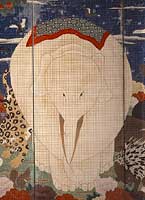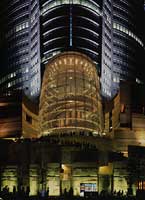|
|
|||||||
|
|
|||||||
|
|||||||
| | Web Japan >>| Trends in Japan >> | Arts & Entertainment >> | Museum in the Sky | |
|
MUSEUM IN THE SKY Art Gallery Debuts on 52nd Floor of New Skyscraper (December 17, 2003)
MAM is open until 10 p.m. on Mondays, Wednesdays, and Thursdays and until midnight on Sundays, Fridays and Saturdays. Those who visit after dark can enjoy not only paintings, statues, and other objects of art but also the breathtaking nighttime skyline of downtown Tokyo. The museum is the cultural centerpiece of the Roppongi Hills development project, built around the 54-story Mori Tower and housing movie theaters, a hotel, and over 200 shops and restaurants. Roppongi Hills is a commercial, residential, and cultural complex that has become one of Tokyo's most talked-about attractions. More than 26 million people have flocked there in the first six months after its opening on April 25, 2003. Happiness Is . . . "Happiness" was co-curated by MAM Director David Elliott—the first non-Japanese museum director in Japan—with Italian guest curator Pier Luigi Tazzi and Yamashita Yuji of Meiji Gakuin University. The works on display were gathered from 150 museums and collections around the world. Preparations took two years, as the co-curators discussed the theme, met with the artists, chose the works to be displayed, and organized the layout.
Beacon of Art "We hope to make the Mori Art Museum a leading and world-class cultural center on a par with the Louvre in Paris and the Museum of Modern Art in New York," says Mori Minoru, president and chief executive officer of the Mori Building Company and developer of Roppongi Hills. He and his wife, Yoshiko—the chairperson of the museum board—have been longtime supporters of the arts and have been visiting museums around the world since plans for MAM were first drawn up 15 years ago. "MAM will not put on prepackaged exhibits or simply display artifacts in its collection," adds Mori Yoshiko. "By developing our own concepts and themes, we can become the source of art trends around the globe." The ¥1,500 ($13.63 at 110 yen to the dollar) museum admission price includes access to the observation deck on the fifty-second floor. Such revenues will by no means be enough to cover the cost of operating the museum, but through new ventures, such as a tie-up with the Museum of Modern Art in New York, MAM is expected to emerge as an important forum for the contemporary art movement in Japan and the rest of Asia. Related Web SitesMori Art Museum Roppongi Hills Copyright (c) 2004 Web Japan. Edited by Japan Echo Inc. based on domestic Japanese news sources. Articles presented here are offered for reference purposes and do not necessarily represent the policy or views of the Japanese Government. |
TEMPLE TREASURES (September 22, 2003) TRIUMPHANT HOMECOMING (March 15, 2002) TAKING THE ART WORLD BY STORM (February 27, 2001) |
|||||||
|
||||||||




